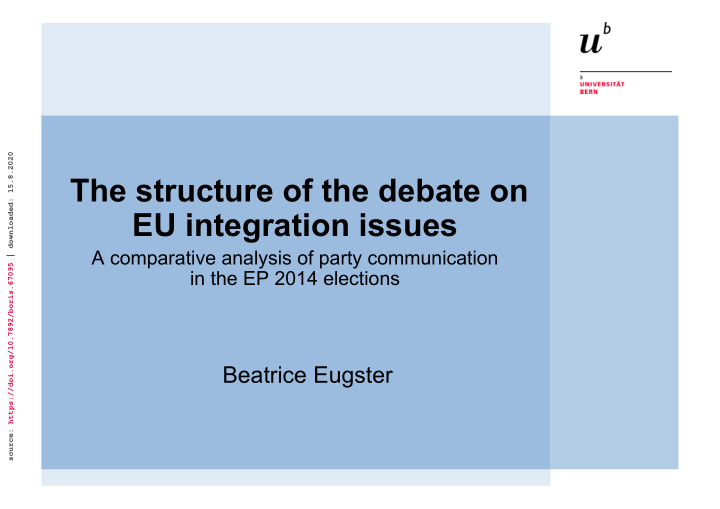



source: https://doi.org/10.7892/boris.67095 | downloaded: 15.8.2020 The structure of the debate on EU integration issues A comparative analysis of party communication in the EP 2014 elections Beatrice Eugster
Research question How is the debate on European integration issues structured? Focus on: on the political conflicts at the EU level > salient EU issues addressed by parties >
From national political conflicts to European political conflicts Left Right All issues National level
From national political conflicts to European political conflicts Libertarian Cultural Economic Right issues issues Left Right All issues Left National level Authoritarian
From national political conflicts to European political conflicts EU level 1a 1b Libertarian Cultural Economic Right All EU issues EU issues EU issues Left Right Left Authoritarian Libertarian Cultural Economic Right issues issues Left Right All issues Left National level Authoritarian
From national political conflicts to European political conflicts EU level Libertarian Cultural Economic Right All EU issues EU issues EU issues Left Right Left Authoritarian EU EU 2a 2b dimension dimension Libertarian Cultural Economic Right issues issues Left Right All issues Left National level Authoritarian
From national to European political cleavages (cont.) (1) Absorption of EU issues along national political conflicts: a) one single dimension: – general left-right dimension (Tsebelis and Garrett’ regulation model) – left-libertarian/right-authoritarian dimension (Kitschelt 1994, Hooghe et al. 2002) b) in two dimensions: – economic and cultural dimension (Kriesi et al. 2006, 2008) (2) No absorption , but emergence of a EU-specific dimension , in addition to the: a) left-right divide (Hix-Lord model, and Marks-Hooghe model) b) economic and cultural dimensions (Bakker et al. 2012) For an overview see also Marks and Steenbergen 2002
Parties’ positions on European integration: the economic and political/ cultural dimension Dilemma of mainstream parties with regard to European integration Social democrats : divided on economic/market integration à competition from radical left (economic demarcation) Conservatives (and Christian democrats) : divided on cultural integration à competition from radical right (cultural demarcation) Liberals : divided on political dimension (opposition to further political integration)
Hypotheses – issues and positions parties follow in their political campaign “Distraction from internal party division” Parties on the left tend to focus stronger on and support cultural/ > political integration , while parties on the right put more emphasis on and support economic integration . EU crisis as a chance to emphasize party division Parties on the left tend to focus stronger on and support (regulative) > economic integration , while parties on the right put more emphasis on and oppose cultural/political integration. Peripheral/fringe parties Peripheral parties on the left tend to focus stronger on and oppose > economic integration , while fringe parties on the right put more emphasis on and oppose cultural/political integration .
Methodological approach Press releases referring to the European Union published 12 > weeks before the 2014 EP elections in 7 countries — Austria, France, Germany, Greece, Netherlands, Portugal, and the UK) or a selection thereof – suggestions are very welcome. Indicator(s): combination of issues and positions > communicated by political parties Comparison across countries >
Party positions: Economic and cultural dimension Party position in Austria (2010) Party position in France (2010) 10 10 FN MPF FPO gal/tan or new politics position gal/tan or new politics position 8 8 BZO OVP UMP 6 6 MARTIN MODEM NC 4 SPO 4 PCF PRG PS 2 2 VERTS GRUNE 0 0 0 2 4 6 8 10 0 2 4 6 8 10 economic left/right position economic left/right position Party position in Portugal (2010) Party position in the UK (2010) Source: Chapel Hill Expert Survey. Source: Chapel Hill Expert Survey. 10 10 BNP CDS − PP gal/tan or new politics position gal/tan or new politics position 8 8 UKIP PSD CONS 6 6 LAB 4 4 SNP PLAID LIBDEM PS 2 2 CDU GREEN BE 0 0 0 2 4 6 8 10 0 2 4 6 8 10 economic left/right position economic left/right position Source: Chapel Hill Expert Survey. Source: Chapel Hill Expert Survey.
Party positions: Economic and cultural dimension Party position in Germany (2010) Party position in Greece (2010) 10 10 LAOS gal/tan or new politics position gal/tan or new politics position 8 8 ND CSU DIKKI CDU KKE 6 6 LINKE SPD 4 4 FDP PASOK 2 2 SYRIZA Grunen OP 0 0 0 2 4 6 8 10 0 2 4 6 8 10 economic left/right position economic left/right position Party position in the Netherlands (2010) Source: Chapel Hill Expert Survey. Source: Chapel Hill Expert Survey. 10 SGP gal/tan or new politics position 8 CU PVV CDA 6 SP VVD 4 PvdA PvdD 2 GL D66 0 0 2 4 6 8 10 economic left/right position Source: Chapel Hill Expert Survey.
From national political conflicts to parties’ position towards European integration Parties Economic Cultural/political dimension dimension (market integration) (integration) Social democrats Internal division integration Mainstream parties Christian democrats integration integration Conservatives integration demarcation Liberals integration Internal division Radical left demarcation (moderate) integration Peripheral parties Greens (moderate) demarcation (moderate) integration Radical right demarcation demarcation Based on : Marks and Wilson 2000, Hooghe et al. 2004, Marks 2004, Kriesi 2007
Issue categorization - (2) «inductive» logic Issue categorization (EU project) • Economy • Social and labor market policy • Education and research (1) Empirical verification whether two • Law and order dimensions – economic and cultural – can be • Immigration found (based on issue position) • International Affairs • Culture and Other (2) «Alternative version»: combination of issue • Environment and Energy position (pro/contra) and the specific • Infrastructure justification of the position • Agriculture and Food • Economic • Consumer protection • Cultural (ethnic, religious, political) • Citizens’ rights • Other • Constitutional questions and functioning of EU • (no justification) • Territorial questions • Administration and bureaucracy (corruption) • Elections
Recommend
More recommend